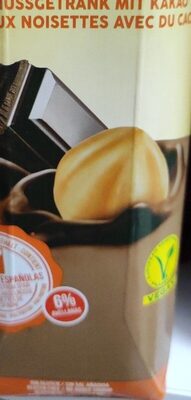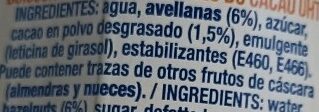Help us make food transparency the norm!
As a non-profit organization, we depend on your donations to continue informing consumers around the world about what they eat.
The food revolution starts with you!
Bebida de avellanas con cacao - Nectina - 1 l
Bebida de avellanas con cacao - Nectina - 1 l
This product page is not complete. You can help to complete it by editing it and adding more data from the photos we have, or by taking more photos using the app for Android or iPhone/iPad. Thank you!
×
Barra-kodea: 8412737220255 (EAN / EAN-13)
Izen arrunta: Bebida de avellanas con cacao UHT
Kopurua: 1 l
Ontziratzea: en:multilayer-composite, Tetra Pak, Tetra Brik
Markak: Nectina
Kategoriak: en:Plant-based foods and beverages, en:Beverages, en:Plant-based foods, en:Dairy substitutes, en:Milk substitutes, en:Nuts and their products, en:Plant-based beverages, en:Plant-based milk alternatives, en:Nut-based drinks, en:Hazelnut-based drinks, es:Bebida de avellanas con cacao, es:Bebida de cacao
Etiketak, ziurtagiriak, sariak:
en:Vegetarian, en:Vegan, en:European Vegetarian Union, en:European Vegetarian Union Vegan

Origin of the product and/or its ingredients: Avellana: España
Origin of ingredients: Espainia, es:Tarragona
Manufacturing or processing places: Tarragona
Link to the product page on the official site of the producer: http://www.nectina.com
Saltzen diren herrialdeak: Espainia
Matching with your preferences
Health
Osagaiak
-
9 ingredients
: Agua, avellanas (6%), azúcar, cacao en polvo desgrasado (1,5%), emulgente (lecitina de girasol), estabilizantes (E460, E466)Alergenoak: en:NutsAztarnak: en:Nuts
Food processing
-
Ultra processed foods
Elements that indicate the product is in the 4 - Ultra prozesatutako elikagaiak eta edariak group:
- Gehigarria: E322
- Gehigarria: E460 - Zelulosa
- Gehigarria: E466
- Osagaia: Emulsifier
Food products are classified into 4 groups according to their degree of processing:
- Prozesatu gabeko edo ahalik eta gutxien prozesatutako elikagaiak
- Sukaldaritzako osagaiak prozesatu
- Prozesatutako jakiak
- Ultra processed foods
The determination of the group is based on the category of the product and on the ingredients it contains.
Gehigarriak
-
E322
Lecithin: Lecithin -UK: , US: , from the Greek lekithos, "egg yolk"- is a generic term to designate any group of yellow-brownish fatty substances occurring in animal and plant tissues, which are amphiphilic – they attract both water and fatty substances -and so are both hydrophilic and lipophilic-, and are used for smoothing food textures, dissolving powders -emulsifying-, homogenizing liquid mixtures, and repelling sticking materials.Lecithins are mixtures of glycerophospholipids including phosphatidylcholine, phosphatidylethanolamine, phosphatidylinositol, phosphatidylserine, and phosphatidic acid.Lecithin was first isolated in 1845 by the French chemist and pharmacist Theodore Gobley. In 1850, he named the phosphatidylcholine lécithine. Gobley originally isolated lecithin from egg yolk—λέκιθος lekithos is "egg yolk" in Ancient Greek—and established the complete chemical formula of phosphatidylcholine in 1874; in between, he had demonstrated the presence of lecithin in a variety of biological matters, including venous blood, in human lungs, bile, human brain tissue, fish eggs, fish roe, and chicken and sheep brain. Lecithin can easily be extracted chemically using solvents such as hexane, ethanol, acetone, petroleum ether, benzene, etc., or extraction can be done mechanically. It is usually available from sources such as soybeans, eggs, milk, marine sources, rapeseed, cottonseed, and sunflower. It has low solubility in water, but is an excellent emulsifier. In aqueous solution, its phospholipids can form either liposomes, bilayer sheets, micelles, or lamellar structures, depending on hydration and temperature. This results in a type of surfactant that usually is classified as amphipathic. Lecithin is sold as a food additive and dietary supplement. In cooking, it is sometimes used as an emulsifier and to prevent sticking, for example in nonstick cooking spray.Source: Wikipedia (Ingeles)
-
E322i - Lezitina
Lecithin: Lecithin -UK: , US: , from the Greek lekithos, "egg yolk"- is a generic term to designate any group of yellow-brownish fatty substances occurring in animal and plant tissues, which are amphiphilic – they attract both water and fatty substances -and so are both hydrophilic and lipophilic-, and are used for smoothing food textures, dissolving powders -emulsifying-, homogenizing liquid mixtures, and repelling sticking materials.Lecithins are mixtures of glycerophospholipids including phosphatidylcholine, phosphatidylethanolamine, phosphatidylinositol, phosphatidylserine, and phosphatidic acid.Lecithin was first isolated in 1845 by the French chemist and pharmacist Theodore Gobley. In 1850, he named the phosphatidylcholine lécithine. Gobley originally isolated lecithin from egg yolk—λέκιθος lekithos is "egg yolk" in Ancient Greek—and established the complete chemical formula of phosphatidylcholine in 1874; in between, he had demonstrated the presence of lecithin in a variety of biological matters, including venous blood, in human lungs, bile, human brain tissue, fish eggs, fish roe, and chicken and sheep brain. Lecithin can easily be extracted chemically using solvents such as hexane, ethanol, acetone, petroleum ether, benzene, etc., or extraction can be done mechanically. It is usually available from sources such as soybeans, eggs, milk, marine sources, rapeseed, cottonseed, and sunflower. It has low solubility in water, but is an excellent emulsifier. In aqueous solution, its phospholipids can form either liposomes, bilayer sheets, micelles, or lamellar structures, depending on hydration and temperature. This results in a type of surfactant that usually is classified as amphipathic. Lecithin is sold as a food additive and dietary supplement. In cooking, it is sometimes used as an emulsifier and to prevent sticking, for example in nonstick cooking spray.Source: Wikipedia (Ingeles)
-
E460 - Zelulosa
Cellulose: Cellulose is an organic compound with the formula -C6H10O5-n, a polysaccharide consisting of a linear chain of several hundred to many thousands of β-1→4- linked D-glucose units. Cellulose is an important structural component of the primary cell wall of green plants, many forms of algae and the oomycetes. Some species of bacteria secrete it to form biofilms. Cellulose is the most abundant organic polymer on Earth. The cellulose content of cotton fiber is 90%, that of wood is 40–50%, and that of dried hemp is approximately 57%.Cellulose is mainly used to produce paperboard and paper. Smaller quantities are converted into a wide variety of derivative products such as cellophane and rayon. Conversion of cellulose from energy crops into biofuels such as cellulosic ethanol is under development as a renewable fuel source. Cellulose for industrial use is mainly obtained from wood pulp and cotton.Some animals, particularly ruminants and termites, can digest cellulose with the help of symbiotic micro-organisms that live in their guts, such as Trichonympha. In human nutrition, cellulose is a non-digestible constituent of insoluble dietary fiber, acting as a hydrophilic bulking agent for feces and potentially aiding in defecation.Source: Wikipedia (Ingeles)
-
E466
Carboxymethyl cellulose: Carboxymethyl cellulose -CMC- or cellulose gum or tylose powder is a cellulose derivative with carboxymethyl groups --CH2-COOH- bound to some of the hydroxyl groups of the glucopyranose monomers that make up the cellulose backbone. It is often used as its sodium salt, sodium carboxymethyl cellulose.Source: Wikipedia (Ingeles)
Ingredients analysis
-
en:Palm oil free
No ingredients containing palm oil detected
-
en:Vegan
No non-vegan ingredients
-
en:Vegetarian
No non-vegetarian ingredients detected
-
Details of the analysis of the ingredients
: Agua, avellanas 6%, azúcar, cacao en polvo desgrasado 1.5%, emulgente (lecitina de girasol), estabilizantes (e460, e466)- Agua -> en:water - vegan: yes - vegetarian: yes - ciqual_food_code: 18066 - percent_min: 85.8 - percent_max: 91
- avellanas -> en:hazelnut - vegan: yes - vegetarian: yes - ciqual_food_code: 15004 - percent_min: 6 - percent: 6 - percent_max: 6
- azúcar -> en:sugar - vegan: yes - vegetarian: yes - ciqual_proxy_food_code: 31016 - percent_min: 1.5 - percent_max: 3.7
- cacao en polvo desgrasado -> en:fat-reduced-cocoa-powder - vegan: yes - vegetarian: yes - ciqual_food_code: 18100 - percent_min: 1.5 - percent: 1.5 - percent_max: 1.5
- emulgente -> en:emulsifier - percent_min: 0 - percent_max: 1.5
- lecitina de girasol -> en:sunflower-lecithin - vegan: yes - vegetarian: yes - percent_min: 0 - percent_max: 1.5
- estabilizantes -> en:stabiliser - percent_min: 0 - percent_max: 1.5
- e460 -> en:e460 - vegan: yes - vegetarian: yes - percent_min: 0 - percent_max: 1.5
- e466 -> en:e466 - vegan: yes - vegetarian: yes - percent_min: 0 - percent_max: 0.75
- Avellana: España
Avellana -> en:hazelnut
Elikadura
-
Good nutritional quality
⚠ ️Warning: the amount of fruits, vegetables and nuts is not specified on the label, it was estimated from the list of ingredients: 6This product is not considered a beverage for the calculation of the Nutri-Score.
Positive points: 0
- Proteinak: 0 / 5 (balioa: 1, rounded value: 1)
- Fiber: 0 / 5 (balioa: 0.8, rounded value: 0.8)
- Fruits, vegetables, nuts, and colza/walnut/olive oils: 0 / 5 (balioa: 6, rounded value: 6)
Negative points: 0
- Energia: 0 / 10 (balioa: 270, rounded value: 270)
- Azukreak: 0 / 10 (balioa: 3.7, rounded value: 3.7)
- Gantz saturatua: 0 / 10 (balioa: 0.7, rounded value: 0.7)
- Sodioa: 0 / 10 (balioa: 40, rounded value: 40)
The points for proteins are counted because the negative points are less than 11.
Nutritional score: (0 - 0)
Nutri-Score:
-
Nutrient levels
-
Koipe in moderate quantity (3.4%)
What you need to know- A high consumption of fat, especially saturated fats, can raise cholesterol, which increases the risk of heart diseases.
Recommendation: Limit the consumption of fat and saturated fat- Choose products with lower fat and saturated fat content.
-
Gantz-azido ase in low quantity (0.7%)
What you need to know- A high consumption of fat, especially saturated fats, can raise cholesterol, which increases the risk of heart diseases.
Recommendation: Limit the consumption of fat and saturated fat- Choose products with lower fat and saturated fat content.
-
Azukre in moderate quantity (3.7%)
What you need to know- A high consumption of sugar can cause weight gain and tooth decay. It also augments the risk of type 2 diabetes and cardio-vascular diseases.
Recommendation: Limit the consumption of sugar and sugary drinks- Sugary drinks (such as sodas, fruit beverages, and fruit juices and nectars) should be limited as much as possible (no more than 1 glass a day).
- Choose products with lower sugar content and reduce the consumption of products with added sugars.
-
Gatz arrunt in low quantity (0.1%)
What you need to know- A high consumption of salt (or sodium) can cause raised blood pressure, which can increase the risk of heart disease and stroke.
- Many people who have high blood pressure do not know it, as there are often no symptoms.
- Most people consume too much salt (on average 9 to 12 grams per day), around twice the recommended maximum level of intake.
Recommendation: Limit the consumption of salt and salted food- Reduce the quantity of salt used when cooking, and don't salt again at the table.
- Limit the consumption of salty snacks and choose products with lower salt content.
-
-
Nutrition facts
Nutrition facts As sold
for 100 g / 100 mlAs sold
per serving (200 ml)Compared to: en:Hazelnut-based drinks Energia 270 kj
(65 kcal)540 kj
(130 kcal)+% 48 Koipe 3,4 g 6,8 g +% 62 Gantz-azido ase 0,7 g 1,4 g +% 204 Gantz-azido monoasegabe 2,4 g 4,8 g Polyunsaturated fat 0,3 g 0,6 g Carbohydrates 7,2 g 14,4 g +% 44 Azukre 3,7 g 7,4 g +% 6 Fiber 0,8 g 1,6 g Proteina 1 g 2 g +% 89 Gatz arrunt 0,1 g 0,2 g -% 7 Fruits‚ vegetables‚ nuts and rapeseed‚ walnut and olive oils (estimate from ingredients list analysis) 6 % 6 %
Ingurumena
-
Eco-Score A - Very low environmental impact
The Eco-Score is an experimental score that summarizes the environmental impacts of food products.→ The Eco-Score was initially developped for France and it is being extended to other European countries. The Eco-Score formula is subject to change as it is regularly improved to make it more precise and better suited to each country.Life cycle analysis
-
Average impact of products of the same category: B (Score: 79/100)
Kategoria: Almond drink not sweet, not fortified, prepacked
Kategoria: Almond drink not sweet, not fortified, prepacked
- PEF environmental score: 0.06 (the lower the score, the lower the impact)
- including impact on climate change: 0.37 kg CO2 eq/kg of product
Stage Impact Agriculture
37.0 %Processing
24.3 %Ontziratzea
16.2 %Transportation
15.6 %Distribution
6.9 %Consumption
0.0 %
Bonuses and maluses
-
Origins of ingredients with a low impact
Bonus: +18
Environmental policy: +3
Transportation: +15
Origin of the product and/or its ingredients % of ingredients Impact Espainia 100 %Baxua
-
Packaging with a low impact
Malus: -4
Shape Material Recycling Impact 1 Brick Tetra Brik ecoponto-amarelo Medium
Eco-Score for this product
-
Impact for this product: A (Score: 93/100)
Produktua: Bebida de avellanas con cacao - Nectina - 1 l
Life cycle analysis score: 79
Sum of bonuses and maluses: +14
Final score: 93/100
-
Carbon footprint
-
Equal to driving 0.2 km in a petrol car
37 g CO² per 100g of product
The carbon emission figure comes from ADEME's Agribalyse database, for the category: Almond drink not sweet, not fortified, prepacked (Source: ADEME Agribalyse Database)
Stage Impact Agriculture
19.2 %Processing
18.5 %Ontziratzea
26.9 %Transportation
31.6 %Distribution
3.9 %Consumption
0.0 %
Ontziratzea
-
Packaging with a low impact
-
Packaging parts
1 x Brick 1 L (Tetra Brik: 0.042 g)
-
Bilgarriaren materialak
Material % Bilgarriaren pisua Bilgarriaren pisua produktuaren 100g-ko
-
Transportation
-
Origins of ingredients
Origins of ingredients with a low impact
Origin of the product and/or its ingredients % of ingredients Impact Espainia 100 %Baxua
Report a problem
-
Incomplete or incorrect information?
Category, labels, ingredients, allergens, nutritional information, photos etc.
If the information does not match the information on the packaging, please complete or correct it. Open Food Facts is a collaborative database, and every contribution is useful for all.
Datuen iturria
Product added on by elcoco
Last edit of product page on by nectinaoriginal.
Produktuaren orria -gatik editatua duhowpi, itsjustruby, kiliweb, spotter, yuka.sY2b0xO6T85zoF3NwEKvlkxXcvnY_2LGaBnUtFah6NGjALPjbf55v5PTKKs.










